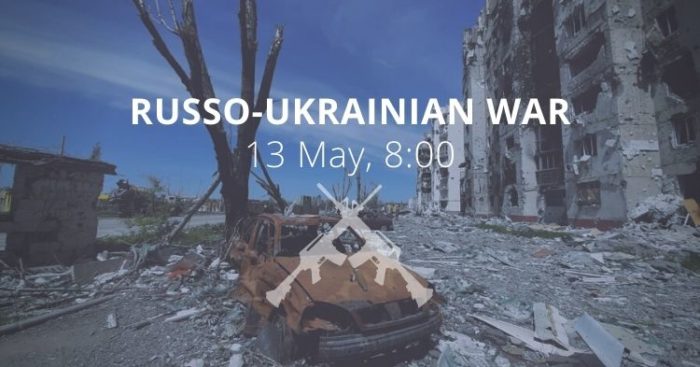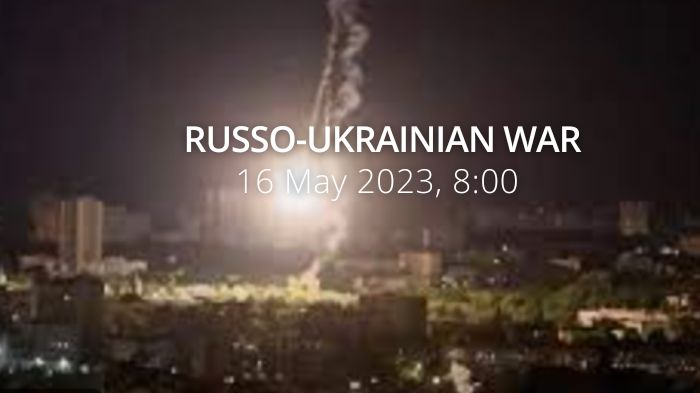Daily overview — Summary report, January 5, 2023
A map of the approximate situation on the ground in Ukraine as of 00:00 UTC 05/01/23.
— War Mapper (@War_Mapper) January 5, 2023
There have been no notable changes to control since the last update. pic.twitter.com/xlJYliNzRY
The General Staff’s operational update regarding the Russian invasion as of 18.00 pm, January 5, 2023 is in the dropdown menu below:
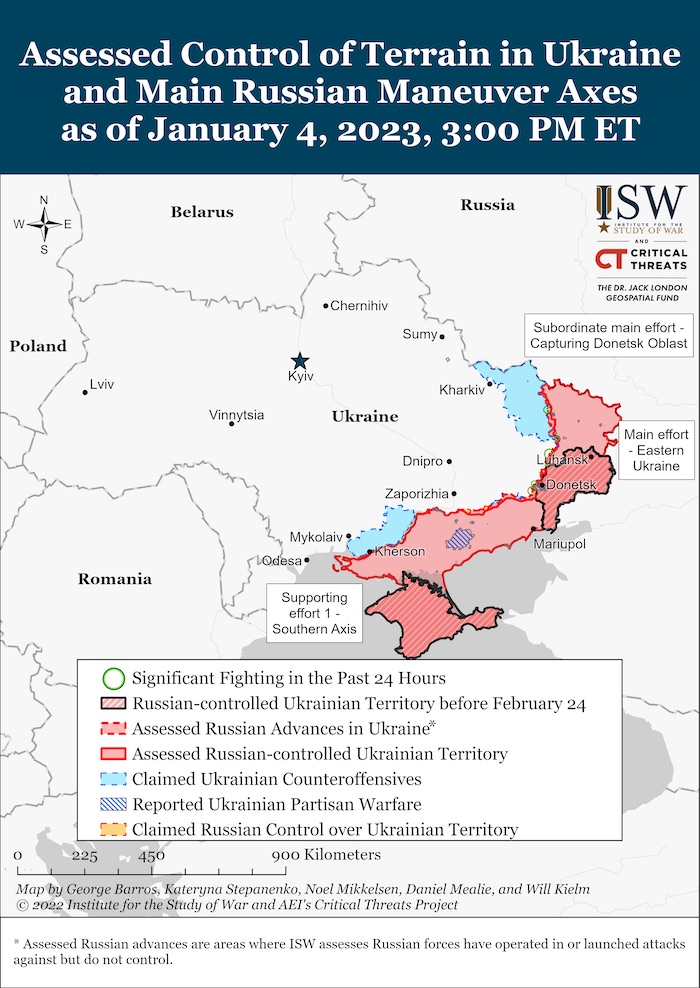
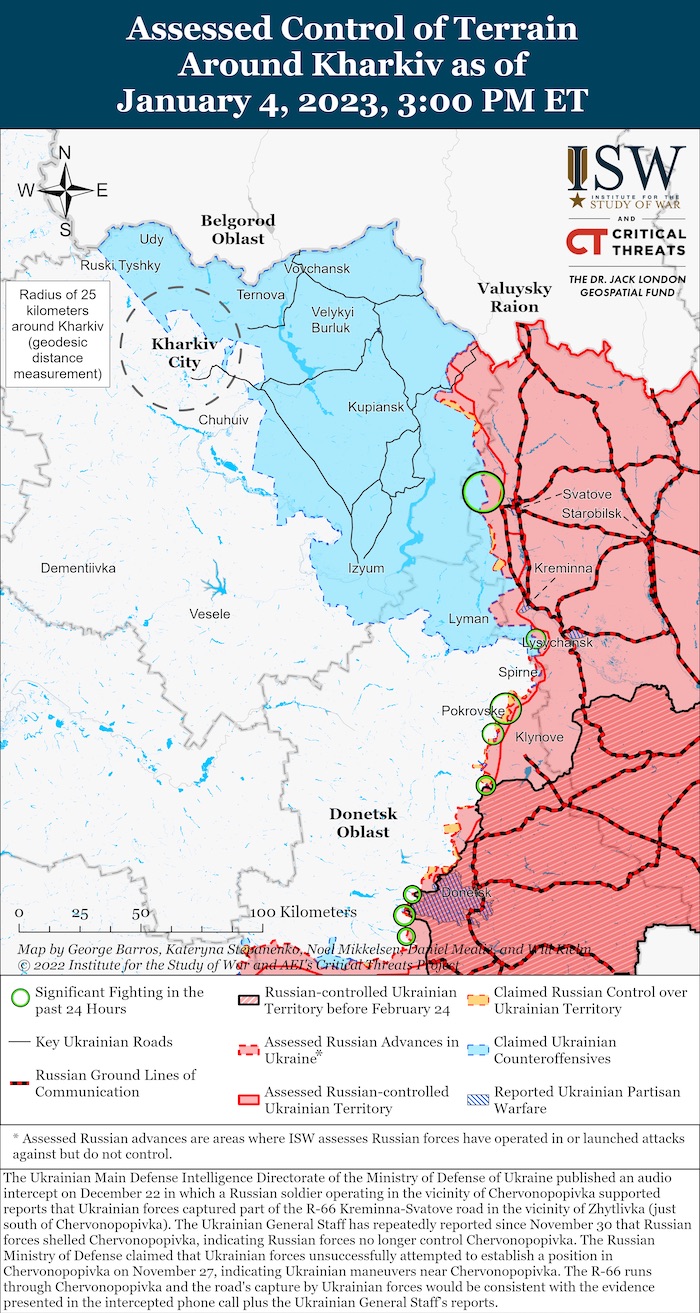
- In the Siversky and Slobozhanskyy, the districts of Kamianska Sloboda, Chernihiv region, were hit by tank, mortar and artillery shelling; Kustyne, Maiske and Pavlivka in Sumy Oblast and Krasne, Staritsa, Ohirtseve, Gatishche, Vovchansk, Ustinivka and Figolivka in Kharkiv Oblast.
- In the Kupiansk and Lyman directions, areas of 20 settlements were affected by fire. Among them are Ivanivka, Kupiansk, Dvorichna, Vilshana, Kislivka, Kotlyarivka and Krokhmalne in Kharkiv Oblast and Makiivka, Ploshanka and Dibrova in Luhansk Oblast.
- In the Bakhmut and Avdiivka directions, areas of more than 40 settlements were shelled. In particular, these are Verkhnokamianske, Bilogorivka, Bakhmut, Bila Gora, Diliivka, Avdiivka, Nevelske, Krasnohorivka, Mariinka and Novomykhailivka of the Donetsk region.
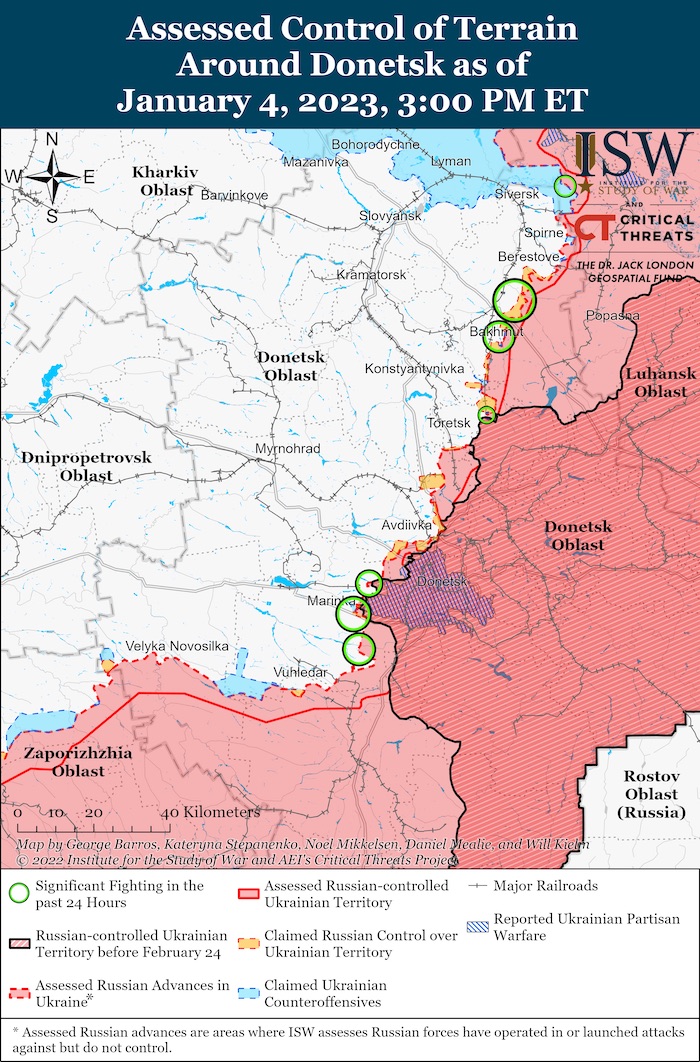
- In the Novopavlivsk direction, enemy fire was recorded near the settlements of Zolota Niva, Vugledar, Mykilski Dachi and Prechistivka in the Donetsk region.
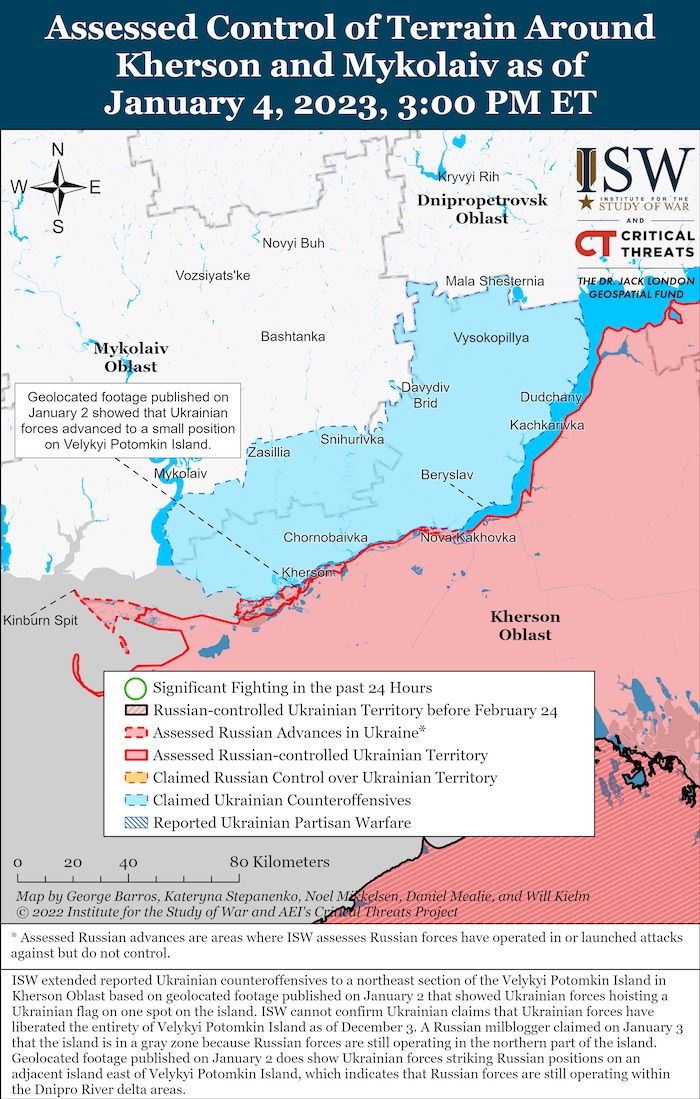
- In the Zaporizhzhia and Kherson directions, the areas of more than 45 settlements were affected by the fire. The civil infrastructure of Poltavka, Gulyaipilske, Mala Tokmachka and Stepove settlements of the Zaporizhzhia region and Kherson, Novosilka, Tyaginka and Sadove were damaged by tank, mortar and artillery shelling.
Military Updates
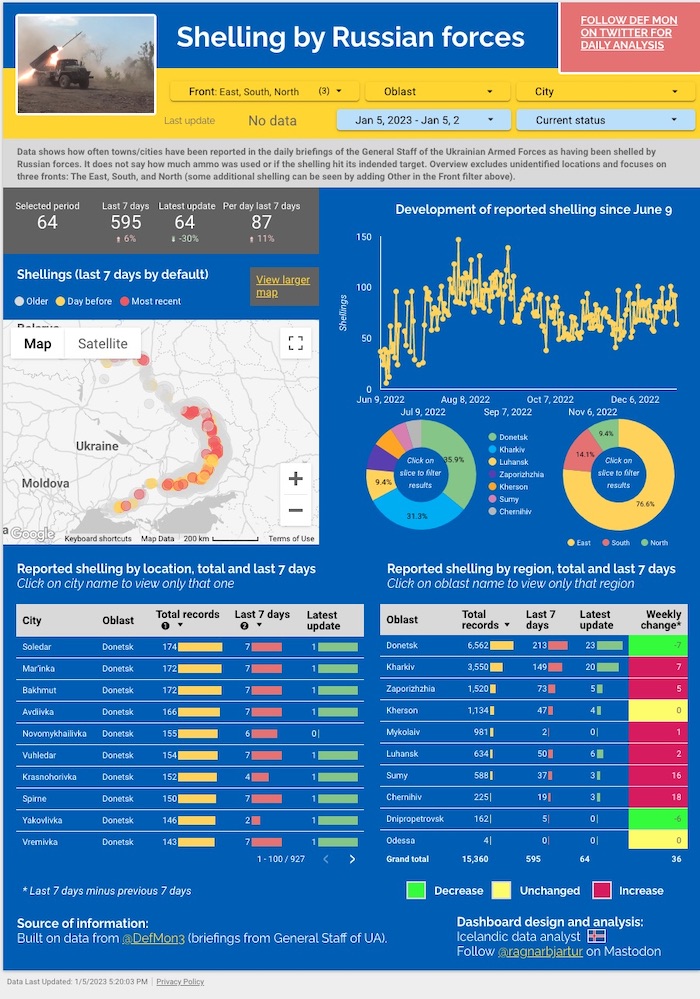
- On 27 December 2022, Oleksiyy Danilov, secretary of Ukraine’s National Security and Defence Council, reported that Russia had relocated long-range aviation (LRA) Tu-95MS BEAR heavy bombers and Tu-22M3 BACKFIRE medium bombers to Russia’s far east.
- On 5 and 26 December 2022, the LRA’s Engels air base was struck and several aircraft damaged. Russia has highly likely responded to the incidents by conducting a general dispersal of LRA aircraft, especially to airfields further away from Ukraine.
- The LRA will still be able to fire air-launched cruise missiles into Ukraine because the weapons have a 5000km range, in addition to the flight range of the bombers. However, operating from dispersal locations will add additional maintenance stress and will further deplete the limited flying hours available on these ageing aircraft.
- On 31 December 2022, Ukraine struck a school building in the Russian-held town of Makiyivka near Donetsk city, which Russia had almost certainly taken over for military use. The building was completely destroyed and, as the Russian MoD confirmed, 89 Russian personnel were killed.
- Given the extent of the damage, there is a realistic possibility that ammunition was being stored near troop accommodation, which detonated during the strike creating secondary explosions.
- The building was only 12.5km from the Avdiivka sector of front line, one of the most intensely contested areas of the conflict. The Russian military has a record of unsafe ammunition storage from well before the current war, but this incident highlights how unprofessional practices contribute to Russia’s high casualty rate.
Losses of the Russian army
As of Thursday 5 January, the approximate losses of weapons and military equipment of the Russian Armed Forces from the beginning of the invasion to the present day:"Today, two [Russian] warehouses with ammunition were destroyed in the Bakhmut area, one in the Avdiivka area, and another in the Lyman area [all in Donetsk Oblast]," Serhii Cherevatyi, spox for the Eastern Group of Troops said.https://t.co/VcUfXHKCK6
— Euromaidan Press (@EuromaidanPress) January 4, 2023
- Personnel – about 109720 (+810),
- Tanks – 3041 (+3),
- Armoured combat vehicles – 6108 (+2),
- Artillery systems – 2051 (+12),
- Multiple rocket launchers –MLRS - 426 (+2),
- Air defence means – 215 (+0),
- Aircraft - 284 (+1),
- Helicopters - 271 (+1),
- Automotive technology and fuel tanks – 4759 (+14),
- Vessels/boats - 16 (+0),
- UAV operational and tactical level – 1844 (+2),
- Special equipment – 182 (+1),
- Mobile SRBM system – 4 (+0),
- Cruise missiles – 723 (+0)
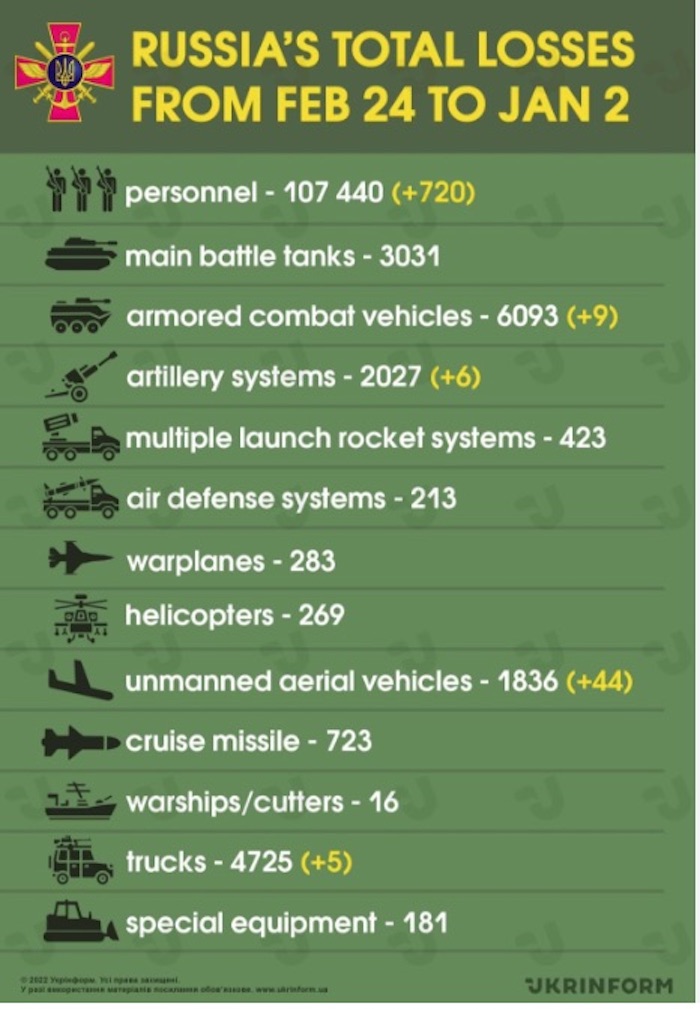
Humanitarian
Ukraine sees speeding up inspections as key to Black Sea grain deal, Reuters reports. Ukraine's efforts to increase exports under the Black Sea grain deal with Russia are currently focused on securing faster inspections of ships rather than including more ports in the initiative, a senior Ukrainian official said on Wednesday. Ukraine is a major global grain producer and exporter, but production and exports have fallen since Russia invaded the country last February and started blockading its seaports. Three leading Ukrainian Black Sea ports in the Odesa region were unblocked in July under an initiative between Moscow and Kyiv brokered by the United Nations and Türkiye. Under the deal, all ships are inspected by joint teams in the Bosphorus. Kyiv accuses Russia of carrying out the inspections too slowly, causing weeks of delays for ships and reducing the supply of Ukrainian grain to foreign markets. Russia has denied slowing down the process. […] Ukraine exported around 7 million tonnes of agricultural products in September and October and 6 million in November, but shipments fell sharply to less than 4 million in December. Kyiv attributes the drop to a slowdown of inspections. Ukraine's infrastructure ministry said on Tuesday that no new vessels were currently expected to arrive in Ukraine for loading. It said 94 vessels were waiting for inspection in the Bosphorus, including 69 empty vessels for loading and 25 which had already been loaded with agricultural products. Vessels are waiting for an average of more than a month, the ministry said.” Some 4.9M IDPs in Ukraine - Ministry of Social Policy, Ukrinform reports, citing the Ministry of Social Policy. “Almost 4.9 million IDPs have been registered, of which more than 3.5 million people have moved after February 24, 2022, the statement says. According to the Ministry, throughout the year more than 1.8 million displaced persons received accommodation assistance. More than UAH 57 billion was laid down in the state budget to cover these expenses.”Environmental
Energoatom discusses the inability of the IAEA to create a safety zone at the ZNPP, Ukraine Business News reports. “The head of state energy company Energoatom, Petro Kotin, does not believe that the IAEA will be able to achieve the creation of a safety zone around the Zaporizhzhia nuclear power plant. In his opinion, Ukraine has a better chance of reclaiming the nuclear power plant through military means. In particular, according to Bloomberg, Kotin assumes that in the event of a successful offensive by the Armed Forces of Ukraine in the Zaporizhzhia region and the de-occupation of Melitopol, the Russians will have no other option but to leave the NPP. In an interview with Reuters, he proposed an alternative involving UN peacekeepers. As a permanent member of the UN Security Council, Russia can block the creation of a peacekeeping mission. Still, according to the head of Energoatom, this will only increase general awareness of Moscow’s actions.”Europe gas falls again as warm weather brings relief for markets
— Euromaidan Press (@EuromaidanPress) January 4, 2023
Benchmark futures fell as much as 7.8% to the lowest since mid-February.https://t.co/0jxfwGIjAg
Over 20% of Ukraine's arable land is temporarily occupied - agrarian policy minister, Ukrinform reports, citing Minister of Agrarian Policy and Food Mykola Solskyi. "Now, nearly over 20% of arable land is not under the control of Ukraine – these areas of land are under occupation, he said. Solskyi added that the areas where winter wheat and corn, as well as sunflower, were mainly sown remain occupied. The minister emphasized that these lands are also contaminated with mines. As reported by Ukrinform, according to preliminary estimates of the Ministry of Agrarian Policy, more than 1 million hectares of soil in Ukraine was affected by Russia’s full-scale invasion.” Millions of refugees from Ukraine have crossed borders into neighbouring countries, and many more have been forced to move inside the country. The escalation of conflict in Ukraine has caused civilian casualties and destruction of civilian infrastructure, forcing people to flee their homes seeking safety, protection and assistance the UNHCR reports. As of 3 January:Last night Russian hit central-Ukrainian city of Zaporizhzhia with S-300 missiles, injuring one - President's Office
— Euromaidan Press (@EuromaidanPress) January 4, 2023
An infrastructure facility was hit, the blast wave damaged a nearby five-storey residential building and parked cars.https://t.co/cOEMtF5Qsp pic.twitter.com/Pviar8iann
| Individual refugees from Ukraine recorded across Europe: | 7,915,287 |
| Bulgaria, Czech Republic, Hungary, Poland, Republic of Moldova, Romania, Slovakia | 2,428,282 |
| Other European countries | 2,616,823 |
| Russian Federation, Belarus | 2,870,182 |
| Refugees from Ukraine registered for Temporary Protection or similar national protection schemes in Europe: | 4,905,293 |
| Bulgaria, Czech Republic, Hungary, Poland, Republic of Moldova, Romania, Slovakia | 2,419,288 |
| Other European countries | 2,486,005 |
| Border crossings from Ukraine (since 24 February 2022): | 17,139,782 |
| Border crossings to Ukraine (since 28 February 2022): | 9,180,679 |
Legal
Ukraine’s Security Service issues notices of suspicion to 2 Russian commanders for attacking civilian facilities, Ukrainska Pravda reports, citing SSU. “The Security Service of Ukraine (SSU) has issued the first notices of suspicion for the shelling of civilian facilities in Ukraine to Colonel General Sergei Kobylash, commander of the Russian Air Force's Long-Range Aerospace Forces, and Admiral Igor Osipov, the former Commander of the Russian Black Sea Fleet [a notice of suspicion is an important initial stage of a pre-trial investigation under Ukrainian criminal procedure law - ed.]. In the course of the investigation, investigators from the SSU have found that since the beginning of the full-scale invasion, Sergei Kobylash has been following instructions from Russia's top military and political leadership regarding the destruction of Ukrainian cities.” Prosecutors already targeting 635 suspects in “main case” probing Russian aggression against Ukraine, Ukrinform reports, citing the Prosecutor General's Office. “The Main Case of Russian aggression toward Ukraine involves as many as 635 suspects at the moment. Among the 635 suspects are military and political leaders of the Russian Federation: ministers, MPs, officials, heads of law enforcement agencies, warmongers, and Kremlin propagandists. In total, Ukrainian law enforcement registered 62,480 crimes of aggression and war crimes. Of these, 60,734 are related to violations of the laws and customs of war, 67 – to planning, preparation for or starting and waging a war of aggression, 40 – to propaganda of war, etc. In addition, 17,369 crimes against national security were registered: 10,434 – regarding encroachment on the territorial integrity and inviolability of Ukraine, 1,913 – treason, 3,905 – collaborative activities, 383 – aiding and abetting the aggressor state, 62 – sabotage, etc.” 452 children were killed, 877 children injured, 13,876 deported by foe forces, and 354 reported missing - the Office of the Prosecutor General of Ukraine reports as of January 5. 3,126 educational establishments are damaged as a result of shelling and bombings, and 337 of them are destroyed fully. 62,480 crimes of aggression and war crimes and 17,369 crimes against national security were registered.#Russia abducted and tortured over a thousand civilians, including children in #Kherson oblast of #Ukraine alone #LetMyPeopleGo #StandWithUkraine #RussiaWarCrimes #StopRussiahttps://t.co/dhBkgK6YeZ pic.twitter.com/jx6CFd5ndR
— Halya Coynash (@halyapuff) January 5, 2023
 The Hague City Council favours the initiative to host a special tribunal to prosecute Russia, Ukrinform reports. “The Hague City Council favored the initiative put forward by VVD (People's Party for Freedom and Democracy) leader Lotte van Basten Batenburg on the creation of a special tribunal to prosecute the Russian Federation in The Hague.
As a member of The Hague City Council, I want The Hague city authorities to do everything possible to support the creation of a special tribunal and to prepare for its location in our city. The Hague is an international city of peace and justice, the ICC and special tribunals for Rwanda and Yugoslavia are already here. Eurojust and Europol are also headquartered here. Therefore, we have the experience and international legal infrastructure to host the future special tribunal which will investigate and prosecute the crimes and atrocities committed during Russia’s war of aggression against Ukraine," Lotte van Basten Batenburg [said].”
The Hague City Council favours the initiative to host a special tribunal to prosecute Russia, Ukrinform reports. “The Hague City Council favored the initiative put forward by VVD (People's Party for Freedom and Democracy) leader Lotte van Basten Batenburg on the creation of a special tribunal to prosecute the Russian Federation in The Hague.
As a member of The Hague City Council, I want The Hague city authorities to do everything possible to support the creation of a special tribunal and to prepare for its location in our city. The Hague is an international city of peace and justice, the ICC and special tribunals for Rwanda and Yugoslavia are already here. Eurojust and Europol are also headquartered here. Therefore, we have the experience and international legal infrastructure to host the future special tribunal which will investigate and prosecute the crimes and atrocities committed during Russia’s war of aggression against Ukraine," Lotte van Basten Batenburg [said].”
Support
https://twitter.com/EuromaidanPress/status/1610834093096275972 Netherlands to help Ukraine win the war, prime minister says, Euromaidan Press reports. “On 3 January, Prime Minister of the Netherlands Mark Rutte said he had a telephone conversation with Ukrainian President Volodymyr Zelenskyy, during which he promised to provide military aid to Ukraine to help defeat Russia. According to Zelenskyy, they discussed the risk of escalation at the front and the potential challenges and Ukraine’s defence needs. “Ukraine has held its own against Russia’s barbaric invasion for almost a year now. The months ahead are crucial. I just spoke to President Volodymyr Zelenskyy and assured him that the Netherlands will do everything it can to help Ukraine not only defend itself but also win the war”, Mark Rutte said on Twitter.” Zelensky and Macron agree on cooperation to strengthen Ukraine’s air defense, Ukrinform reports. “Had a long and detailed conversation with President of France Emmanuel Macron on the current situation, Zelensky posted on Twitter. The President thanked Macron for the decision to transfer light tanks and Bastion APCs to Ukraine, as well as for intensifying work with partners in this direction. Agreed with Emmanuel Macron on further cooperation to significantly strengthen Ukraine’s air defence and other defence capabilities. We also agreed to work on the implementation of the Peace Formula, the President added. […] As reported, President of France Emmanuel Macron promised in his New Year's address to continue to help Ukraine "without delay" and "until its victory".” Ukraine's Foreign Minister Announces New Ramstein Meeting, European Pravda reports. "We have high hopes for new decisions on defenсe assistance from our partners. The next Ramstein meeting will take place soon. It will be crucial for the announcement of new decisions, Dmytro Kuleba, Ukrainian Foreign Minister, said at an online briefing on Wednesday, 4 January. Kuleba has also named the weaponry the Ukrainian army needs most. According to him, the top priorities are anti-aircraft and anti-missile defence systems with ammunition. That is why we will have talks not only on new Patriot batteries but also on new NASAMS, IRIS-T, Crotal systems, the Minister added. Ukraine is also interested in additional Gepard and Vulcan systems, portable anti-aircraft missile systems such as Stinger, and artillery rounds. He has pointed out that Ukraine is currently working with partners to reach a new level of providing the armed forces with artillery systems and armoured vehicles of all types. Even children in Ukraine ask for a leopard for Christmas. We understand that children think not only about toy leopards. We not only think about this but also work very, very hard. I said last year, and I am still convinced that in 2023 we will receive something that, for various reasons, we could not obtain in 2022. I can confirm it. Wait for the news, the Minister underlined.” Norway donates additional artillery shells to Ukraine; the Norwegian Government says in a statement. “Norway donates another 10,000 artillery shells to Ukraine. The material has been sent. The artillery shells can be used in several types of artillery systems, including the M109 that Norway has donated in the past. It is important for Europe's and Norway's security that Ukraine succeeds in standing up to Russia's attack. Ukraine needs international support in the form of military equipment and training of its own forces. Norway has contributed heavily through 2022 and will continue to contribute to support Ukraine in 2023, says the Minister of Defence. The artillery shells are taken from the stockpiles of the Norwegian Armed Forces. The consequence for national preparedness has been assessed.”Biden says Bradley Fighting Vehicles are on the table for Ukraine, Reuters reports. “US President Joe Biden on Wednesday said that sending Bradley Fighting Vehicles to Ukraine was being considered to help the country fight Russia's invasion. It was not clear how many Bradleys are destined for Ukraine, but the United States is preparing another weapons aid package which could be announced in the coming days.” Patriot will start defending Ukraine "as soon as possible", Ukrainska Pravda reports, citing Dmytro Kuleba, Ukrainian Foreign Minister. “The American Patriot air defence system will be deployed in Ukraine as soon as possible. Preparations for the transfer of these systems have already begun.” Ukraine’s Armed Forces to keep shooting down Shahed drones with everything they have, even if it is expensive, Ukrainska Pravda reports, citing Yurii Ihnat, Spokesperson for Air Force of Ukraine. “The Air Force of the Armed Forces of Ukraine consider inappropriate accusations that Ukrainian defenders shoot down Iranian-made Russian drones with much more expensive missiles from Western air defence systems because it is about saving people's lives and the preservation of vital infrastructure. This is how the spokesman for the Air Force of the Ukrainian Armed Forces reacted, in particular, to the New York Times article about Ukraine shooting down cheap drones with expensive missiles.”German Foreign Minister @ABaerbock said there’s little sign that Russian President Putin plans to end his war on Ukraine anytime soon “despite all international efforts.”
— Euromaidan Press (@EuromaidanPress) January 4, 2023
“If Russia stops bombing and withdraws its soldiers, we will have peace,” she addedhttps://t.co/pfJccBTixT
France to send AMX-10 RC armored fighting vehicles to Ukraine following a call between the heads of the two states - DW
— Euromaidan Press (@EuromaidanPress) January 4, 2023
President Zelenskyy thanked his French counterpart, Macron, for the decision to supply the "light tanks" and Bastion APCs to Ukrainehttps://t.co/Yk70AFoObN
New Developments
- Chief of Defence Intelligence predicts Putin's death: Very quickly and soon, Ukrainska Pravda reports, citing ABC News. “Kyrylo Budanov, Chief of the Defence Intelligence of Ukraine, has said that Vladimir Putin, President of Russia, has cancer and will die very soon, but after Ukraine’s win in the war with Russia.”
- Russia is not a military threat to the world anymore, Ukrainska Pravda reports, citing ABC News. “Kyrylo Budanov, the Head of Ukraine’s Defence Intelligence, states that Russia has lost its status as a powerful military state and the world should no longer fear it. Budanov states that Putin's regime is a laughingstock for everyone. The Russian troops are all but reduced to defending territories they still occupy within Ukraine, and not for much longer. According to Budanov, the only issue remaining is Russia's nuclear arsenal and the uncontrollable regime of Putin. This might lead the whole world to realise the necessity of Russia's denuclearization or at least an international overseeing of its nuclear arsenal."
- Putin deploys new Zircon hypersonic cruise missiles to Atlantic, Reuters “President Vladimir Putin sent a frigate to the Atlantic Ocean armed with new generation hypersonic cruise missiles on Wednesday, a signal to the West that Russia will not back down over the war in Ukraine. Russia, China and the United States are in a race to develop hypersonic weapons which are seen as a way to gain an edge over any adversary because of their speeds - above five times the speed of sound - and manoeuvrability.”
- NATO will discuss the war in Ukraine at the January 18-19 meeting, Ukraine Business News “NATO’s highest military body, the Military Committee, will meet on January 18-19 in a face-to-face format in Brussels. 32 defence staff chiefs will participate in a series of meetings to discuss issues of strategic importance for NATO. […]At the final meeting, the Military Committee will discuss NATO’s ongoing support for Ukraine.”
- Germany Open to Seizing Russian Assets to Help Ukraine Rebuild, Bloomberg “Germany is open to using billions of euros in frozen Russian assets to help Ukraine rebuild as long as legal issues can be resolved and allies follow suit. [...] The detail of the discussions shows how the potential for asset seizures is moving beyond a theoretical debate and toward implementation, but major hurdles remain. Scholz wants any move coordinated with allies and legally tight, the people said.”
- Russia reduced the daily gas transit through Ukraine by another 10%, Ukraine Business News “On January 4, the Russian Federation reduced the daily natural gas transit through the Ukrainian GTS to Europe by another 10%, to 38.4 million cubic meters per day. ExPro analysts calculated that this is the lowest level in the entire history of observations since 1991. Currently, Russia transports natural gas through Ukraine to Slovakia and Moldova. Transit to Moldova remains at about 6 million cubic meters per day. However, transit to Slovakia on January 4 decreased from 36.8 to 32.8 million cubic meters. In general, the volume of Russian gas transit is approximately one-third of the guaranteed 109.6 million cubic meters per day capacity booked by Gazprom.”
- Ukrainian ambassador criticises Israel because of conversation with Russian Foreign Minister: it indicates a change in policy, Ukrainska Pravda reports, citing The Times of Israel. “Ukrainian ambassador to Israel Yevhen Korniichuk has criticised the conversation between Eli Cohen, Israelʼs Foreign Minister and Sergey Lavrov, his Russian counterpart. According to Korniichuk, communication with Lavrov indicates a change in the country's policy, since Israeli diplomats have not spoken with Lavrov since the beginning of the war. He also noted Israel's incomprehensible policy regarding the war, because the country in no way condemns massive strikes on critical infrastructure in Ukraine. Israel is unique, from the point of view of our partners. It is silent, Korniichuk said.On 2 January, Eli Cohen, the newly appointed Israeli Foreign Minister, statedthat Israel would start "talking less publicly" about the war between Russia and Ukraine.”
Assessment
- On the war.
The Institute for the Study of War has made the following assessment as of January 4, 2023:
- The Russian milblogger information space continues to seize on official responses to the Ukrainian HIMARS strike on a Russian base in Makiivka to criticize endemic issues in the Russian military apparatus and its unwillingness to address systemic failures.
- The continued construction of Russian units using solely mobilized recruits will not generate combat power commensurate with the number of mobilized personnel deployed.
- The Russian MoD has again shifted the rhetoric and format of its daily situational reports (SITREPs) likely to flood the information space with insignificant claimed successes and distract from its significant military failures.
- Ukrainian Main Military Intelligence Directorate (GUR) Chief Kyrylo Budanov stated that Ukrainian forces intend to launch a major counteroffensive throughout Ukraine in the spring of 2023.
- Russian forces are increasingly reliant upon Iranian-made drones to strike Ukrainian critical infrastructure, and Russia will likely seek further bilateral cooperation with Iran in order to secure a greater number of high-precision weapons systems for use in Ukraine.
- Russian forces continued limited counterattacks to regain lost positions along the Svatove-Kreminna line as Ukrainian strikes reportedly damaged Russian military logistics in Luhansk Oblast.
- Russian forces continued offensive operations around Bakhmut amid continued indicators that the broader offensive may be culminating.
- Russian forces continued offensive operations on the western outskirts of Donetsk City.
- Russian forces continued to rebuild force capability and conduct defensive operations in Kherson Oblast on January 4.
- Select Russian private armament manufacturers are continuing to criticize the Russian military campaign.
- Consequences and what to do?
- repeated Ukrainian breaches of Russian declared red-lines have not triggered the WW3 many were predicting;
- the increasingly more advanced defence support to Ukraine – and the consequential destruction of Russia’s Armed Forces - has not escalated the full-scale war in Ukraine into a military confrontation in Europe;
- the global “tsunami of ripple effects” from the war is not sustainable; and that
- Russia is no longer a military threat to the world.


